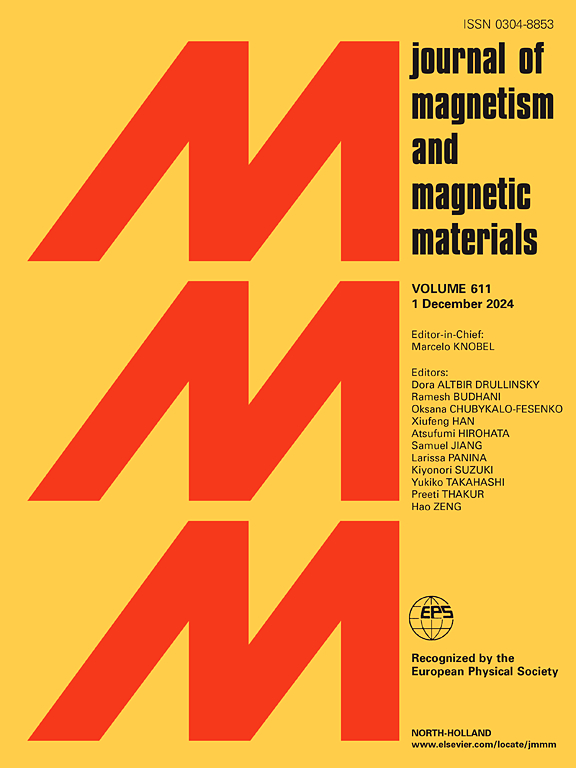热自旋电子用PdFeCrZ (Z = Al, Si, Sb, Ge)季系Heusler合金的半金属铁磁性和热电性能
IF 2.5
3区 材料科学
Q3 MATERIALS SCIENCE, MULTIDISCIPLINARY
引用次数: 0
摘要
利用密度泛函理论(DFT)对PdFeCrZ (Z: Al, Si, Sb, Ge)季元- heusler合金(QHAs)的结构、电子、磁性和热电性能进行了综合分析。初始阶段包括对QHA化学相的细致检查,考虑了三种不同的结构安排(I型、II型和III型结构)。所有化合物在铁磁I型结构中都更稳定。通过计算化合物的形成能和声子色散曲线,证实了化合物的热力学和动力学稳定性。结合PBE泛函和改进的Becke-Johnson (mBJ)方法,采用广义梯度近似(GGA)进行波段结构分析。后者显示PdFeCrAl和PdFeCrSi化合物具有半金属铁磁行为,PdFeCrSb化合物具有接近半金属铁磁行为,而PdFeCrGe化合物无带隙(无自旋间隙)。PdFeCrSb的磁矩值为4.97µB, PdFeCrAl、PdFeCrSi和PdFeCrGe的磁矩值分别为3、4和4µB,符合sllater - pauling规则。利用平均场近似计算了所研究的PdFeCrZ (Z = Al, Si, Sb, Ge)化合物的居里温度。为了评估热性能,采用了玻尔兹曼输运理论,计算了广泛温度范围(300至600 K)内的基本热电性能,包括塞贝克系数(S)、电导率(σ/τ)、热电子导电性(κe/τ)、功率因数(PF)和优值图(zT)。计算得到的zT值在0.56 ~ 0.84之间。所得结果证实了这些化合物在先进热自旋电子器件中的潜在适用性。这项研究很重要,因为它可以为更有效的能量转换和存储技术铺平道路,最终提高下一代电子设备的性能。本文章由计算机程序翻译,如有差异,请以英文原文为准。
Half-metallic ferromagnetism and thermoelectric performance of PdFeCrZ (Z = Al, Si, Sb, Ge) Quaternary Heusler alloys for thermo-spintronic applications
Density Functional Theory (DFT) was utilized for a comprehensive analysis of the structural, electronic, magnetic, and thermoelectric properties of PdFeCrZ (Z: Al, Si, Sb, Ge) Quaternary-Heusler alloys (QHAs). The initial phase involved a meticulous examination of the chemical phase of QHA, considering three distinct structural arrangements (Type I, II, and III structures). All the compounds are more stable in ferromagnetic type I structure. The thermodynamic and dynamic stabilities of the studied compounds were confirmed through the calculation of their formation energy and phonon dispersion curve. The band structure analysis was performed using the Generalized Gradient Approximation (GGA) with the Perdew-Burke-Ernzerhof (PBE) functional and the modified Becke-Johnson (mBJ) approach. The later shows a half metallic ferromagnetic behavior for both PdFeCrAl and PdFeCrSi compounds, nearly half-metallic ferromagnetic behavior for PdFeCrSb, and no band gap for PdFeCrGe (spin gapless). Moreover, the magnetic moments exhibit a value of 4.97 µB for PdFeCrSb, and an integer values of 3, 4 and 4 µB for PdFeCrAl, PdFeCrSi and PdFeCrGe, respectively, consistent with the Slater-Pauling rule. The Curie temperatures of the investigated PdFeCrZ (Z = Al, Si, Sb, Ge) compounds were calculated using the mean-field approximation. To assess thermal performance, Boltzmann’s transport theory was employed, allowing the calculation of essential thermoelectric properties across a broad temperature range (300 to 600 K). These properties include the Seebeck coefficient (S), electrical conductivity (/τ), thermal electronic conductivity (κe/τ), power factor (PF), and the figure of merit (zT). The calculated zT values range between 0.56 and 0.84. The obtained results confirm the potential applicability of these compounds in advanced thermo-spintronic devices. This study is important as it could pave the way for more efficient energy conversion and storage technologies, ultimately enhancing the performance of next-generation electronic devices.
求助全文
通过发布文献求助,成功后即可免费获取论文全文。
去求助
来源期刊

Journal of Magnetism and Magnetic Materials
物理-材料科学:综合
CiteScore
5.30
自引率
11.10%
发文量
1149
审稿时长
59 days
期刊介绍:
The Journal of Magnetism and Magnetic Materials provides an important forum for the disclosure and discussion of original contributions covering the whole spectrum of topics, from basic magnetism to the technology and applications of magnetic materials. The journal encourages greater interaction between the basic and applied sub-disciplines of magnetism with comprehensive review articles, in addition to full-length contributions. In addition, other categories of contributions are welcome, including Critical Focused issues, Current Perspectives and Outreach to the General Public.
Main Categories:
Full-length articles:
Technically original research documents that report results of value to the communities that comprise the journal audience. The link between chemical, structural and microstructural properties on the one hand and magnetic properties on the other hand are encouraged.
In addition to general topics covering all areas of magnetism and magnetic materials, the full-length articles also include three sub-sections, focusing on Nanomagnetism, Spintronics and Applications.
The sub-section on Nanomagnetism contains articles on magnetic nanoparticles, nanowires, thin films, 2D materials and other nanoscale magnetic materials and their applications.
The sub-section on Spintronics contains articles on magnetoresistance, magnetoimpedance, magneto-optical phenomena, Micro-Electro-Mechanical Systems (MEMS), and other topics related to spin current control and magneto-transport phenomena. The sub-section on Applications display papers that focus on applications of magnetic materials. The applications need to show a connection to magnetism.
Review articles:
Review articles organize, clarify, and summarize existing major works in the areas covered by the Journal and provide comprehensive citations to the full spectrum of relevant literature.
 求助内容:
求助内容: 应助结果提醒方式:
应助结果提醒方式:


